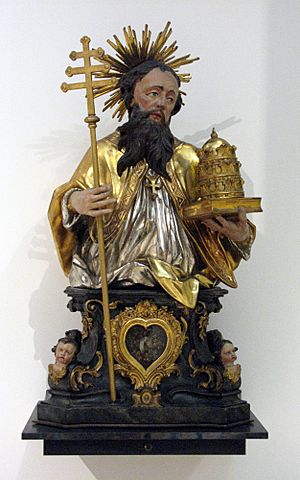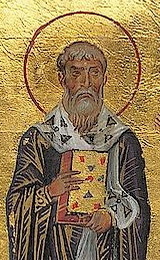Pope Linus facts for kids
Quick facts for kids Pope Saint Linus |
|
|---|---|
| Bishop of Rome | |

|
|
| Papacy began | c. AD 67 |
| Papacy ended | c. AD 76 |
| Predecessor | Peter |
| Successor | Anacletus |
| Personal details | |
| Born | c. AD 10 Volterra, Italia, Roman Empire |
| Died | c. AD 76 (aged 65–66) Rome, Italia, Roman Empire |
| Buried | possibly Vatican Hill |
| Sainthood | |
| Feast day | 23 September |
| Venerated in | All Christian denominations that venerate saints |
| Canonized | Pre-Congregation |
| Attributes | Papal vestments and pallium |
| Patronage | Patronage list |
Pope Linus (pronounced LY-nuss) was an early leader of the Christian Church. He served as the Bishop of Rome from about AD 67 until his death around AD 76. Like many early popes, he is considered a saint.
Some ancient writers, like Irenaeus, believed Linus was the same person mentioned in the New Testament. The Second Epistle to Timothy says Linus was with Paul the Apostle in Rome near the end of Paul's life.
Early Life and Role
The first person to write about Linus as a bishop was Irenaeus around AD 180. He wrote that the apostles Peter and Paul chose Linus to lead the Church in Rome.
Early lists of bishops in Rome, from writers like Irenaeus and Hegesippus, say that Peter and Paul put Linus in charge. This happened after they started the Christian church in Rome. Because of this, some people consider Linus the first pope. However, later on, Peter became known as the first pope.
Other important writers also spoke about Linus's role. Jerome called him "the first after Peter to be in charge of the Roman Church." Eusebius said Linus was "the first to receive the leadership of the church at Rome." This happened after Peter and Paul died as martyrs.
The Liber Pontificalis, an old book about popes, also lists Linus as the second Bishop of Rome after Peter. It says Peter chose Linus and Anacletus to help with church duties. Peter himself focused on prayer and preaching.
The Apostolic Constitutions, another ancient text, states that Paul the Apostle made Linus the first bishop of Rome. It says Linus was followed by Clement I.
Time as Bishop
Different historical sources give slightly different dates for when Linus was bishop. The Liberian Catalogue and the Liber Pontificalis say he served from AD 56 to 67. This was during the time of Emperor Nero. However, Jerome says his time was from AD 67 to 78. Eusebius suggests his leadership ended around AD 80.
Linus is mentioned in the Second Epistle to Timothy. This letter notes that Linus was with Paul the Apostle in Rome. This was near the end of Paul's life. Irenaeus believed this was the same Linus who became the Bishop of Rome.
The Liber Pontificalis says Linus was born in Volterra, a town in Tuscany, Italy. His father's name was Herculanus. The Apostolic Constitutions mentions his mother was Claudia. The Bible also names a Claudia in the same verse as Linus.
The Liber Pontificalis also claims that Linus made a rule for women to cover their heads in church. It also says he appointed the first 15 bishops. This source states he died as a martyr. His death date is given as September 23rd, which is still his feast day. His name is part of the Roman Canon during Mass.
However, some historians question if Linus was truly a martyr. There are no records of Christians being persecuted in Rome between the time of Nero and Domitian. Irenaeus only mentions Telesphorus as a martyr among the early Roman bishops. The Roman Martyrology, a list of saints, does not call Linus a martyr. It simply remembers him as the Pope to whom the apostles entrusted the Church in Rome.
Legacy and Remembrance
In 1615, a tomb was found in Saint Peter's Basilica with the letters "LINVS" on it. People thought it might be the tomb of Pope Linus. However, it was later noted that these letters were likely just the end of a longer name.
An old letter about the deaths of Peter and Paul was once thought to be written by Linus. But it was later found to be from the 6th century, much later than Linus's time. The Liber Pontificalis says Linus was buried on the Vatican Hill. This is near Peter the Apostle, in what is now the Vatican Necropolis under Saint Peter's Basilica.
The town of Saint-Lin-Laurentides in Canada is named in his honor.
See also
 In Spanish: Lino (papa) para niños
In Spanish: Lino (papa) para niños
- List of Catholic saints
- List of popes
- Papal selection before 1059


